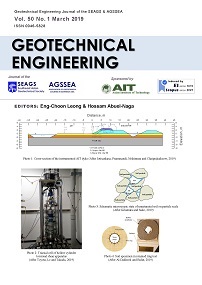Field Response of an Instrumented Dyke subjected to Rainfall
Main Article Content
Abstract
A field study was undertaken of an instrumented dyke on soft Bangkok clay in Pathumthani, Thailand. The studied site was characterised using dynamic cone penetration tests, field vane shear tests and Spectral Analysis of Surface Waves geophysical tests. The porewater pressure, suction, moisture content and rainfall were continuously monitored over the rainy season in 2017. The soft clay nearer the dyke had higher strength than in the zone further away due to consolidation. The upper 0.5 m of dyke fill material made up of silty and clayey soils were found to experience drastic suction changes, reaching 1800 kPa towards the end of a drought and abruptly reducing to 20-40 kPa within a day upon the onset of the rainy season. Such large and abrupt changes of the suction are likely to have aggravated the surface cracking and hence the dyke movements. In contrast, the response at 3 m depth from the dyke shoulder was almost insensitive to the short-term rainfall patterns. Vertical movement of the dyke surface showed compression-swelling phenomena, probably due to the combined effects of drying, collapse-on-wetting and swelling and suggested that some movement is recoverable. This was not the case for horizontal movements, which exhibited constant outwards cumulative displacement.
Article Details

This work is licensed under a Creative Commons Attribution-NonCommercial-NoDerivatives 4.0 International License.
Copyright © 2019 Association of Geotechnical Societies in Southeast Asia (AGSSEA) - Southeast Asian Geotechnical Society (SEAGS).


